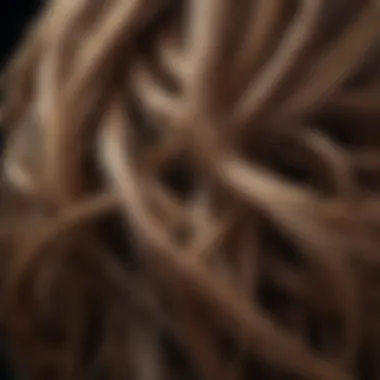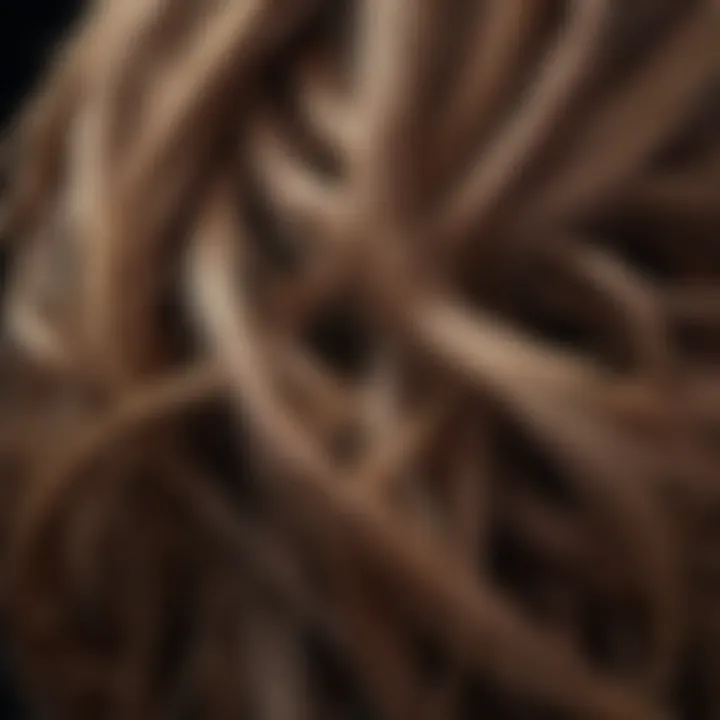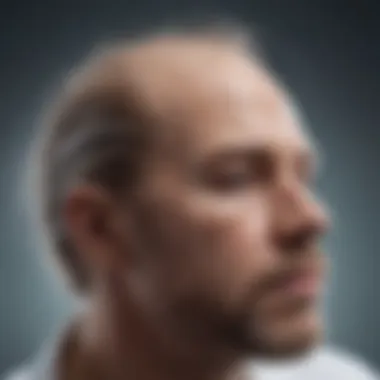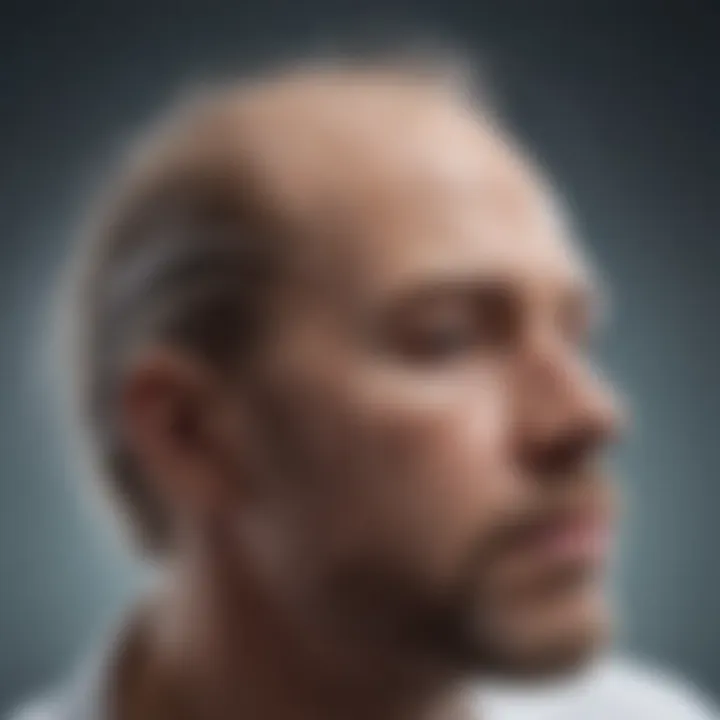Exploring the Multifaceted Uses of Human Hair


Intro
Human hair serves more than just aesthetic purposes; it finds relevance across multiple domains. This organic material possesses several properties that make it both unique and versatile. The scope of its utility extends from personal care to scientific and environmental applications. This article delves into various sectors where human hair is utilized, shedding light on its importance and potential.
By examining the rich variety of functions human hair performs, we discover its role in agriculture, forensic science, medicine, and art. Understanding these aspects not only enriches our appreciation of this material but also highlights its significance in contemporary practices.
Research Highlights
Overview of Key Findings
Research indicates that human hair is a valuable resource in diverse fields. Its fibrous structure lends it qualities that could be harnessed for various applications. Key findings suggest:
- Agricultural Use: Hair can promote soil health and enhance plant growth through its nitrogen content.
- Forensic Applications: In crime investigations, hair analysis can provide crucial evidence regarding identity and presence at a crime scene.
- Medical Innovations: Hair is being studied for its potential uses in treating certain medical conditions, as well as in regenerative medicine.
- Artistic Expressions: Hair has been used in creative works, showcasing its cultural significance throughout history.
Significance of the Research
Recognizing the multifaceted roles of human hair encourages interdisciplinary exploration. The findings provide insights for students, researchers, and professionals across fields. It highlights a need for sustainable practices, particularly with respect to organic waste. Human hair, often dismissed as a trivial byproduct, could play a critical role in addressing global challenges.
"Human hair is more than just a remnant; it is a resource waiting to be explored."
Original Research Articles
Summary of the Article
Various studies illustrate the promising avenues of human hair research. These articles articulate the potential for innovation in different fields. They document how hair can be repurposed effectively. Specifically, one prominent study investigates how hair can be integrated into agricultural practices, promoting natural composting.
Author Contributions
The research is collaborative, with contributions from diverse professionals. Agricultural scientists have explored its uses in enriching soil, while forensic experts continue to refine techniques for analysis. Additionally, medical researchers examine the regenerative properties of hair cells. Each contributor sheds light on a unique application, collectively illustrating the breadth of human hair's utility.
This exploration of human hair is not merely about aesthetic or personal significance. It is about understanding potential applications in broader contexts. As we delve further into each area of interest, we uncover the hidden value of this oft-overlooked material.
Prelims to Human Hair
Human hair holds a significant place in our world, often overlooked as just a byproduct of our biological nature. However, it is anything but trivial. This introduction aims to delve into the multifaceted uses of human hair, highlighting its relevance across various industries and cultures. By understanding that hair represents more than aesthetics, we begin to appreciate its practical applications and cultural dimensions.
Through this exploration, the article intends to reveal how human hair can be effectively utilized in areas such as agriculture, forensic science, healthcare, and art. The discussion offers insights into the unique properties of hair, such as its strength and biodegradability, broadening our perspective on this organic material.
Additionally, the significance of human hair in cultural practices demonstrates its profound impact on identity and self-expression. Recognizing these factors is essential for grasping the full scope of human hair's role in contemporary society, which is where the journey begins.
Understanding the Biology of Hair
Human hair consists primarily of a protein called keratin, which is also found in nails and skin. Each strand of hair grows from a follicle located in the skin. The life cycle of hair is characterized by three main stages: anagen (growth phase), catagen (transition phase), and telogen (resting phase). This biological process dictates how hair behaves, its texture, and even its lifespan.
The structure of hair is complex. It includes three layers: the cuticle (outer layer), cortex (middle layer), and medulla (inner layer). Each layer plays a distinct role in the overall health and appearance of hair. The cuticle, for instance, protects the inner layers and contributes to the shine of healthy hair.
Interestingly, the properties of human hair, such as tensile strength and elasticity, allow it to be manipulated and used in various ways. Researchers have found that hair can be used as a natural fertilizer due to its nitrogen content. Its potential in materials science as a biodegradable resource is also worth noting.
Cultural Significance of Hair
Hair naturally acts as a potent symbol across numerous cultures, often reflecting personal identity, social status, and cultural heritage. Different styles and practices related to hair can signify belonging to specific groups or traditions. An example is the importance of hair in religious practices, like the Sikh tradition of keeping uncut hair, known as Kesh.
The symbolism of hair extends to art and fashion as well. Artists often use hair to explore themes of identity, loss, and beauty. Hair is also a prevalent medium in various forms of craftsmanship, such as weaving and jewelry-making, creating a bridge between functional use and artistic expression.
In many societies, hair rituals mark life transitions, such as birthdays, weddings, or funerals. These practices reinforce social bonds and communal identity.
"Hair is not just a biological remnant; it is a narrative of who we are, telling stories of culture, identity, and even innovation."
In summary, understanding hair from both a biological and cultural perspective can deeply enhance our appreciation for its uses and meanings. This lays a strong foundation for the subsequent sections which will explore these applications in various sectors.


Human Hair in Fashion and Beauty
Human hair holds a significant place in the fashion and beauty industries. It is more than just a part of human anatomy; it plays an essential role in personal expression and transformation. The use of human hair has evolved beyond traditional norms, entering into modern practices that cater to diverse aesthetic needs. By understanding the applications of human hair in fashion, one can appreciate its versatility and importance.
Wigs and Hairpieces
Wigs and hairpieces have been utilized for centuries, serving various purposes. They are not just tools for disguise; they are fundamental in helping individuals achieve desired looks without altering their natural hair. Many people rely on wigs for different reasons, such as medical conditions that lead to hair loss or the desire for a temporary change in appearance.
The quality of hair used in wigs often influences their appeal. Options vary from synthetic materials to high-quality human hair, which provides a more natural look and feel.
"Wigs made from human hair can be styled just like natural hair, offering endless possibilities for creativity."
Human hair wigs and pieces blend seamlessly with natural hair, making them popular choices for both performers and everyday users. Furthermore, advancements in technology have improved the construction of wigs, ensuring better fit and comfort.
Hair Extensions
Hair extensions offer another avenue for utilizing human hair in fashion. They allow individuals to enhance their hairstyle with length, volume, and color without permanent changes to their natural hair. For many, hair extensions are a quick solution for special occasions or testing out different styles.
There are various types of extensions available in the market, including clip-in, tape-in, and fusion extensions. The key to successful hair extension application lies in the quality of the hair used. Human hair extensions provide better blending, styling options, and longevity compared to synthetic alternatives.
Moreover, hair extensions have gained visibility through influencers and celebrities. They represent a significant trend in the beauty industry, empowering individuals to explore personal style while utilizing the unique attributes of human hair.
Sustainable Beauty Practices
The conversation around sustainability continues to grow, and beauty practices are no exception. Human hair can play a role in sustainable beauty, particularly in reducing waste from the salon industry. Salons often have excess hair trimmings that, if managed effectively, can serve various purposes instead of ending up in landfills.
Innovative approaches are emerging, such as using hair to create biodegradable hair extensions or products that minimize environmental impact. Additionally, initiatives that collect human hair for repurposing in environmental and community projects have arisen.
The move towards sustainable practices highlights the importance of viewing human hair not only as an aesthetic component but also as a resource that can contribute to environmental solutions.
Human hair remains integral to the fashion and beauty sectors. From wigs that create new identities to extensions that enhance personal style, and sustainable practices that address ecological concerns, the applications of human hair are diverse and impactful.
Applications of Human Hair in Agriculture
Human hair, usually overlooked, carries potential benefits in agriculture that merit closer examination. This organic material holds unique properties that could aid sustainable farming practices and enhance soil health. By utilizing human hair in agriculture, we can address environmental concerns while promoting innovative solutions.
Natural Fertilizer
Human hair is rich in nitrogen, a critical nutrient for plant growth. When processed properly, it can be used as a natural fertilizer. The keratin in hair breaks down slowly in the soil, providing a steady supply of nitrogen over time. This slow-release aspect makes it an ideal supplement to traditional fertilizers, reducing the risk of nutrient leaching and promoting better soil structure.
Utilizing hair as fertilizer also minimizes waste. In many cultures, hair is simply disposed of, contributing to landfill issues. However, recycling this material into fertilizer not only promotes eco-friendly practices but also nurtures the soil. The introduction of human hair into compost can enhance microbial activity, ultimately enriching compost quality.
"Using human hair as a natural fertilizer showcases how we can repurpose everyday waste into productive assets for agriculture."
This approach is especially significant considering the increasing demand for sustainable agricultural practices amid climate concerns. Farmers who integrate hair into their soil management practices may find that it increases their crop yields while aligning with eco-conscious production methods. Additionally, the employment of human hair in agriculture may encourage research into other organic waste contributions to soil health.
Pest Deterrent
Another intriguing use of human hair in agriculture is its potential as a pest deterrent. When placed around the base of plants or in gardens, hair strands can act as a natural barrier to certain pests. Rodents and other small animals may be deterred by the scent or texture of hair, which can protect crops from destruction.
Using hair in this context aligns with many organic pest control strategies. It provides a non-toxic, sustainable alternative to chemical pesticides, safeguarding both human health and the environment. As farmers and consumers become increasingly aware of the impacts of chemical use, turning to more natural solutions is imperative.
Additionally, this practice can contribute to biodiversity by supporting beneficial insect populations that may otherwise be harmed by chemical treatments. By applying human hair as a pest deterrent, farmers can create a more balanced ecosystem on their farms, promoting resilience and productivity in the long term.
Forensic Applications of Human Hair
Forensic applications of human hair are significant due to their potential for solving crimes and supporting legal proceedings. Hair can serve as a crucial piece of evidence in investigations. Its characteristics, such as color and texture, can link a suspect to a crime scene or victim. The analysis of hair can also reveal personal information about an individual, including their lifestyle and diet. This connection between hair and individual identity makes it a valuable tool inforensic science.
Hair as Evidence
Hair can be an important type of evidence in criminal cases. It can be found at various crime scenes, often offering a critical link between suspects and victims. The examination of hair can determine if it was forcibly removed or if it was shed naturally, which may indicate different scenarios about the nature of the incident. Analysts look for distinguishing features such as:


- Root structure: The presence or absence of a root can provide clues about how the hair was obtained.
- Color and morphology: These factors may help determine the origin of the hair, whether it be human or animal.
- Microscopical characteristics: Specific details at a microscopic level can allow for comparison between samples.
By presenting such details, hair evidence can be integrated into a larger forensic picture, helping to provide insight into the events that transpired.
DNA Analysis Techniques
DNA analysis techniques have advanced significantly in recent years, making hair analysis an even more powerful method in forensic investigations. These techniques include:
- Nuclear DNA analysis: This method retrieves DNA from the hair root, allowing for individual identification. The process is intricate and may require advanced laboratory facilities.
- Mitochondrial DNA analysis: Hair shafts without roots can still provide useful information. Mitochondrial DNA is inherited maternally and can be used to trace lineage. This technique can be especially helpful in cases where nuclear DNA is not available.
The effectiveness of DNA analysis enhances the reliability of hair as evidence. However, it is important to consider factors such as contamination and the age of the hair samples, which can affect results. As forensic methodologies continue to evolve, the role of hair in evidence collection and analysis will likely expand, integrating more sophisticated technologies that enhance its efficacy in solving crimes.
Medical and Healthcare Uses of Human Hair
The medical and healthcare uses of human hair play a critical role in understanding its potential in scientific applications. These applications are often overlooked, yet they provide insight into innovative uses that can enhance medical practices and improve outcomes for patients. Human hair offers unique biochemical properties that can be harnessed in various areas, including biomaterials in science and innovations in tissue engineering.
Biomaterials in Science
Human hair is emerging as a valuable biomaterial in scientific research. Its composition includes keratin, a protein that is significant in biological processes. Keratin is known for its mechanical strength and durability, which makes hair an ideal candidate for various biomedical applications.
Researchers are investigating how human hair can be processed and repurposed for use in wound healing and tissue regeneration. The fibrous structure of hair can be utilized as scaffolding for cells to grow on. This is crucial for regenerative medicine where a scaffold aids in the reconstruction of damaged tissue. Furthermore, studies have indicated that hair-based materials can facilitate controlled drug delivery systems. This is an area of ongoing research; the potential for human hair in creating effective and biocompatible biomaterials could significantly impact medical treatment options.
Innovations in Tissue Engineering
The realm of tissue engineering also benefits from the unique properties of human hair. Innovations are taking place where hair-derived materials can be synthesized to create bioactive composites. Such materials have shown promise in promoting cellular adhesion and proliferation.
One area of focus is hair's potential use in reconstructive surgeries. By forming implants or grafts from human hair, surgeons could offer patients more natural-looking and functional results. Additionally, the biocompatibility of keratin makes it a suitable material for developing artificial skin, which can be particularly helpful for burn victims or those needing extensive skin regeneration.
This focus on sustainable and biocompatible materials reflects a growing desire in the medical field to find alternatives that reduce dependency on synthetic products, which can carry long-term implications for health and the environment.
In summary, the exploration of medical and healthcare uses for human hair opens doors to innovative possibilities. As research continues, the integration of hair into medical applications could reshape various treatment methodologies and offer patients improved recovery pathways.
"Human hair shows substantial promise in biomaterial science, with the potential to revolutionize aspects of tissue engineering and regenerative medicine."
Art and Culture: Creative Uses of Human Hair
The intersection of art and culture with human hair reveals rich and diverse uses that are often overlooked. Historically, hair has been employed not only as a medium of expression but also as a symbol of status and identity. In recent years, artists and craftspeople have rediscovered hair's unique qualities to create stunning artworks, accessories, and historical artifacts. This section explores how hair is transformed into art, its cultural implications, and the significance of these practices.
Hair Art and Craftsmanship
Hair art encompasses a wide range of practices that utilize human hair in creative ways. Craftsmanship with hair is noted for its intricate nature, requiring significant skill and dedication. Artists may weave hair into elaborate sculptures, jewelry, or other decorative items. The quality of hair lends itself to a variety of textures and appearances, adding depth to the final product.
- Hair Weaving: This technique involves weaving strands into patterns or shapes, often used in jewelry making or decorative displays.
- Hair Painting: This method involves using hair to create images or designs on surfaces, showcasing both the elasticity and the color variations of different hair types.
- Mixed Media Art: Some artists incorporate hair into broader mixed media works, combining it with other materials such as cloth, metals, or paper to create unique structures.
Hair art serves as both an homage to the past and commentary on contemporary issues, such as identity and memory. Artists like Penny Byrne use hair creatively to evoke nostalgia and explore personal narratives. This practice urges a re-evaluation of what constitutes art and which materials deserve recognition.
Historical Context of Hair in Art
Throughout history, hair has played multifaceted roles in various cultures. In many instances, human hair has been used not just for aesthetic purposes but also as a means of preserving memories, honoring the deceased, and expressing grief.
- Victorian Hair Art: In the 19th century, during the Victorian era, hair became a popular medium for memorial art. People created intricate designs from the hair of loved ones, transforming it into brooches and lockets. This practice was both a demonstration of affection and a means to keep a part of the deceased close.
- Cultural Symbolism: Various cultures have their own interpretations of hair in art. In some traditions, hair is seen as a source of power and spirituality, often used in ceremonial items or garments.
- Feminist Art Movement: In contemporary times, hair has been embraced by feminist artists to challenge societal norms about beauty and femininity. Works by artists like Miriam Schapiro have incorporated hair to explore themes of gender identity and cultural representation.
Overall, the historical use of hair in art showcases its dynamic role in shaping cultural narratives. The evolving applications and meanings of hair reflect broader societal changes around personal and collective identity.
Hair as a medium not only captures the physical but also engages with emotional and cultural dimensions, allowing for deep personal and communal expressions.
Ecological Considerations of Human Hair
Human hair, often overlooked in discussions about ecological sustainability, warrants attention for its unique properties and potential environmental benefits. This section delves into two significant aspects of hair's ecological role: its biodegradability and its application in solving environmental challenges. By recognizing these facets, we can appreciate how this organic material contributes positively to ecological practices.


Biodegradability of Hair
Human hair is biodegradable, which means it can decompose naturally over time without causing harm to the environment. This property makes hair an attractive alternative to synthetic materials that persist in landfills for decades. When hair is discarded, it contributes to soil enrichment, providing a slow-release source of nitrogen and other nutrients crucial for plant growth.
In comparison to other organic materials, hair decomposes relatively slowly, which can be beneficial in applications that require a gradual nutrient release. For instance, incorporating hair into compost can enhance the overall quality of soil, especially in community gardens. The presence of hair fibers in mulch can also help retain moisture, aiding plant health in arid conditions.
Key Benefits of Hair Biodegradability:
- Reduces waste in landfills
- Enriches soil with nutrients
- Improves moisture retention in gardening
- Provides a sustainable resource for organic farming
Utilization in Environmental Solutions
Beyond biodegradability, human hair has demonstrated an ability to support various environmental solutions. Its fibrous structure makes it an excellent candidate for a range of innovative uses. For example, hair can be repurposed to address issues related to water pollution. Due to its natural ability to absorb oils and pollutants, hair can be effectively utilized in cleaning oil spills.
Organizations have begun to create mats and booms from processed hair that capture oil, providing an effective means of containment. In this way, human hair shifts from being a waste product to a vital element in ecological restoration efforts.
Furthermore, hair can be integrated into erosion control methods. When planted alongside vegetation, hair can help stabilize soil, reducing the risk of erosion, particularly in areas prone to deforestation or heavy rainfall.
Applications of Hair in Environmental Solutions:
- Oil spill cleanup using hair booms
- Soil stabilization to prevent erosion
- Fertilizer in organic farming practices
- Moisture retention in horticulture
"Human hair, while often disregarded, reveals significant ecological potential when integrated into sustainable practices."
Future Directions and Innovations Involving Human Hair
The exploration of future directions and innovations involving human hair is crucial in the context of this article. As society continues to prioritize sustainability and resourcefulness, the potential uses of human hair emerge not just as academic curiosity but as practical solutions to real-world challenges. This section delves into the ongoing research and developments, showcasing how this organic material can be refined to serve in diverse fields.
Emerging Research Areas
Research into the applications of human hair is expanding rapidly. One of the most exciting areas is biomaterials. Researchers are investigating how keratin, a protein found in human hair, can be utilized in wound dressings and tissue engineering. Initial findings suggest that keratin-based materials enhance healing processes and are biocompatible.
Another promising research avenue is the use of hair in regenerative medicine. Stem cells derived from hair have shown potential for use in therapies for various conditions, including alopecia and even certain genetic disorders. These studies highlight how human hair can transform into a valuable resource in medical science, creating pathways to innovative treatments.
Additionally, environmental research is gaining momentum. Scientists are assessing the role of human hair in carbon sequestration. Hair’s natural properties may help reduce carbon footprints when integrated into biodegradable materials or used as a soil amendment. This enhances the ecological potential of human hair, aligning with global sustainability goals.
Some potential emerging areas include:
- Biodegradable plastics: Combining hair with other organic materials to create eco-friendly plastics.
- Water absorption technology: Exploring hair for filtration systems due to its natural absorbent qualities.
- Bioengineering: Using hair in composite materials for better performance in various industries.
Potential Industrial Applications
As research continues, the industrial sector stands ready to adopt human hair in numerous applications. Its unique properties lend themselves to innovative utilizations across many fields.
- Textile Industry: Hair can be spun into fibers to create textiles. Tailors might use strong keratin fibers to produce durable materials, designed for both fashion and function.
- Construction Materials: Research is ongoing into using human hair as an additive in cement and other construction materials. The fibers can enhance strength while also being a sustainable option.
- Cosmetic Products: With the push for natural ingredients in beauty products, human hair is being tested in formulas for skin and hair care. Its keratin content is particularly beneficial.
- Gardening: Some gardening companies explore using human hair as a slow-release fertilizer. The nitrogen-rich composition can enhance plant growth, making it an excellent organic alternative.
- Craft and Decor: Artisans are considering human hair in crafting high-end goods. The unique textures can elevate the aesthetics of handmade products.
These developments indicate a shift in how human hair is perceived—moving from waste to a valuable commodity. As research progresses, it is essential for institutions and industries to explore these possibilities, enhancing the value of hair in modern contexts.
"Recognizing the multifaceted utility of human hair opens doors to a variety of innovative applications, bridging gaps in sustainability and functional design."
From advances in biomaterials to industrial applications, the journey of human hair takes on new life, promising to contribute positively to industries and ecology.
The End: Recognizing the Value of Human Hair
Human hair is often undervalued and dismissed as a mere waste product. However, this organic material carries significant potential across various domains. The versatility and unique properties of human hair present opportunities that go beyond traditional perceptions. It is important to recognize that hair can be a resource, one that contributes to ecological sustainability, scientific advancements, and creative expression.
Summary of Applications
The applications of human hair are vast and varied. Some key areas include:
- Fashion and Beauty: Wigs and hairpieces have long been popular, and hair extensions are now common in styling. Sustainable beauty practices using human hair have emerged, promoting an eco-friendly approach in this industry.
- Agriculture: In gardening and farming, human hair has been used effectively as a natural fertilizer and as a pest deterrent. Its nitrogen-rich composition benefits soil and plants.
- Forensics: Hair analysis plays a crucial role in criminal investigations. It provides valuable evidence, while DNA testing from hair strands enhances accuracy in identifying suspects.
- Medical Uses: Biotechnological applications using human hair include potential innovations in tissue engineering. The use of hair as bio-materials is an emerging area of research.
- Art and Culture: Human hair has also found its way into the art world, with artists creating unique works and exploring historical contexts surrounding the use of hair in artistry.
- Ecology: The biodegradability of hair presents possibilities for its utilization in environmental solutions, supporting waste reduction and sustainability initiatives.
Final Thoughts on Future Utility
Looking ahead, the future utility of human hair appears promising. Emerging research areas focused on hair's applications in various fields could lead to breakthroughs. Potential industrial applications are expanding everywhere from beauty to healthcare. As awareness of human hair's value grows, it encourages innovative thinking and sustainable practices.
To fully harness these benefits, collaboration across disciplines will be necessary. Researchers, artists, and industry professionals should actively engage in exploring creative solutions using what has often been overlooked. Recognizing the value of human hair is not just about acknowledging its current uses; it is also about envisioning its untapped potential for the future.







